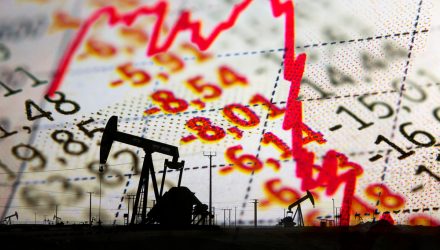The Energy Select Sector SPDR Fund (NYSEArca: XLE) and other energy ETFs are among the worst laggards among sector assets. Oil demand destruction at the hands of the coronavirus pandemic is a big reason why energy is one of the worst-performing groups in the S&P 500, but there is some good news on that front.
Over the course of the pandemic, it wasn’t hard to find forecasts saying that oil demand would take years to return to 2019 levels. Some banks even said pre-pandemic demand may never be seen again. However, rosier assumptions are now in play.
“Assuming a second coronavirus-induced lockdown is averted, global crude oil prices will continue their slow grind higher, reaching $50 per barrel by year’s end and closing in on pre-pandemic levels near $60/bbl by the end of 2021, according to recent forecasts from analysts,” reports S&P Global Market Intelligence.
XLE seeks to provide investment results that correspond generally to the price and yield performance of publicly traded equity securities of companies in the Energy Select Sector Index, which includes securities of companies from the following industries: oil, gas, and consumable fuels; and energy equipment and services.
Much Needed Relief
“Oil prices will advance in 2021 and trend toward a level between $55/bbl and $60/bbl by the end of 2021, Evercore ISI analyst Doug Terreson said,” reports S&P Global Market Intelligence.
Some data points indicate sell-side analysts remain bullish on energy stocks, including some XLE components. Valuation may be one reason why. The recent sell-off may have opened up a potential buying opportunity for bargain hunters, especially in the oversold energy sector.
On the supply side, Iraq said it would cut output by a further 400,000 barrels per day in August and September to compensate for overproduction in the past three months in a bid to comply with its share of cuts set out by the Organization of Petroleum Exporting Countries and its allies, or OPEC+.
“Global oil demand is expected to be very weak for 2020, with estimates calling for a decline of between 8 million bbl/d and 9 million bbl/d, Terreson said. However, as demand rebounds amid a recovery in the economy, consumption could return to 2019 levels by 2022,” according to S&P Global Market Intelligence.
XLE is showing some signs of life as the benchmark energy sector ETF is higher by almost 4% over the past month.
For more alternative investing ideas, visit our Alternatives Channel.
The opinions and forecasts expressed herein are solely those of Tom Lydon, and may not actually come to pass. Information on this site should not be used or construed as an offer to sell, a solicitation of an offer to buy, or a recommendation for any product.








